SECTION 1 & 2- ( 11/24/13 BALVIHAR WEEK :9)
Beginning prayers
- Sahanaavavatu
- Meditation for 5 minutes
- Gurustotram verses 1-9 and 14th verse
Gita chanting
- Chapter 14 - 1st to 4th verse
- Raadhe Raadhe Raadhe
- Dashaavataram Stotram - 1-5 stanza
- Kardama And Devahuti
- Kapila
Likhita Japa
- Writing ‘Om’
Ending prayers and pledge
- sarve bhavantu sukhinah
- puurnamadah purnamidam
- arati
- Pledge
Bhagvatam Time:
We did the recap of the stories we did last week and continued with our stories.
Tale: Kardama And Devahuti
Kardama was a great sage who used to do tapas for many years. He prayed to the Lord to bless him with a beautiful wife. After many years, the Lord appeared before him and blessed him. He promised him very soon Manu, the first man is going to come to him and give his daughter in marriage to him.
Manu and Shataroopa, the first man and woman had 2 sons and 3 daughters. It was time for one of their daughter to get married. Manu and Shataroopa started looking for a suitable groom. One day Narada Ji came there and asked them to find sage Kardama and get their daughter married to him. So Manu and Shataroopa went to the forest looking for the sage and came across a beautiful ashram on the banks of river saraswati and found a young sage who was doing tapas. Manu and Shataroopa offered their daughter, Devahuti in marriage. But the sage had one condition. He told once he bears a son he will leave the ashram and go for the ultimate realisation. Every one agreed. And Kardama and Devahuti both liked each other and thus got married. They lived many years a hard life of penance and sacrifice. After many years of tapas, nine girls were born to them and then after many years a son was born to them. He was named Kapila. After Kapila's birth, sage Kardama left his ashram and went for doing tapas.
Brainstorming: What is Tapas?
Tapas means austerity. When we take a vow to do something and live by that vow, we are doing tapas.
Tale: Kapila
Kapila, son of Kardama and Devahuti, became famous as a divine teacher and a sage. He founded the Saamkhyan philosophy. He was so learned that one day his mother came to him and asked her son, Kapila to teach her how to gain freedom from the cycle of birth and death. Kapila told his mother to attain that one must have a pure heart. One can gain a pure heart by following the 7 rules;
- Obeying the rules of life
- Performing one's duties
- Seeing work as worship
- Chanting God's name again and again
- Trusting God as a trusted, beloved friend
- Seeing the blessed Lord in all creatures; being friendly to all, and being kind to the poor and the helpless
- Loving God as one loves oneself and one's own children. Love for God is devotion.
Devahuti followed her son's teachings faithfully. Then, Kapila left the ashram and went up into the Himalayas for meditation.
Bhagavat Gita chanting:
We did till the 5th verse. Kids keep practicing at home too. Make sure they practice loudly at home too in order to get the words. The audio is available in our chinmaya mission website. Please click on to the link below and will be able to hear the mp3 version by Swami Brahmananda. It is a very easy learning tool which can help us and the kids too.
Likhita Japa:
We couldn't do the Likhita Japa in class. Please make sure to do at home.
We did the arati and pledge in the auditorium. See you all after two weeks until then keep practising.
Note:
Warm Regards,
Kids are supposed to bring their "My Prayers" book and their Gita Chanting handouts every week for their balvihar classes. They are supposed to bring in a note book and pencil for their likhita japa. For the Gita Chanting practice at home you can log on to Chinmayavrindavan.org.
Warm Regards,
Deepthy Aunty & Rama Aunty (Section 1)
Indira Aunty & Shrinivas Uncle (Section 2)


